| 10 Agorot | |
|---|---|
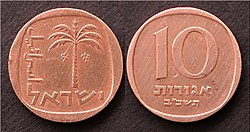
| |
| Obverse: Date palm tree. Lettering ישראל in Hebrew and اسرائيل in Arabic languages. | Reverse: Denomination and lettering אגורות תשכ״ב in Hebrew. |
| Total 247,874,000 coins minted from 1960 to 1977. | |
The Agora (/æɡəˈrɑː/; plural Agorot /-ˈrɒt/; Hebrew: אגורה, pl. אגורות, agorot) is a denomination of the currency of Israel. The Israeli currency – the Israeli new shekel (ILS)– is divided into 100 agorot.
History
The name agora refers to the subunits of three distinct Israeli currencies.
This name was used for the first time in 1960, when the Israeli government decided to change the subdivision of the Israeli pound (Hebrew: לירה, lira) from 1,000 prutah to 100 agorot due to the currency's depreciation. The name was suggested by the Academy of the Hebrew Language, and was borrowed from the Hebrew Bible:
וְהָיָה כָּל-הַנּוֹתָר בְּבֵיתְךָ יָבוֹא לְהִשְׁתַּחֲוֹת לוֹ לַאֲגוֹרַת כֶּסֶף וְכִכַּר-לָחֶם ...every one that is left in thine house shall come and crouch to him for a piece of silver and a loaf of bread...— I Samuel 2:36
The term "piece of silver" appears in Hebrew as "agorat kessef".
In 1980 the Israeli pound was replaced by the shekel at a rate of IL10 per IS 1. The new subdivision of the shekel was named agora ẖadaša ("new agora"). There were 100 new agorot in 1 shekel. The high rate of inflation in Israel in the early 1980s forced the Israeli government to change the Israeli currency once again in 1985. The new shekel was introduced at a rate of 1000 S per 1 NS. The name agora was used once again for its subdivision. This time the term "new" was avoided, in order to prevent confusion with the older subdivision (the pre-1980 agora was long since out of circulation). Currently, the term agora refers to the 100th part of the new shekel. There are coins of 10 and 50 agorot, though the 50 agorot coin bears the inscription: "1⁄2 New Shekel".
The 1 agora coin was withdrawn from circulation on April 1, 1991 by the Bank of Israel, as was the 5 agorot coin on January 1, 2008; in each case the value had shrunk to much less than the cost of production. Cash rounding has since been applied for purchases, such that the total price is now rounded to the nearest multiple of 10 agorot for payment in cash, but to 1 agora for payment by other means like payment cards or cheques.
Issues
Israeli pound
| Image | Value | Technical parameters | Description | Date of | ||||
|---|---|---|---|---|---|---|---|---|
| Diameter (mm) | Mass (g) | Composition | Obverse | Reverse | Issue | Withdrawal | ||

|
1 agora | 20 | 1.03 | aluminium 97%, magnesium 3% | Three ears of barley, "Israel" in Hebrew and Arabic | Value, date | 01.01.1960 | 22.02.1980 |

|
5 agorot | 17.5 | 2.30 (copper) 0.8 (alum.) | 1960—1975: copper 92%, aluminium 6%, nickel 2% | Three pomegranates, "Israel" in Hebrew and Arabic | |||

|
10 agorot | 21.5 | 4.15 (copper) 1.55 (alum.) | 1960—1977: copper 92%, aluminium 6%, nickel 2% | Palm tree, "Israel" in Hebrew and Arabic | |||
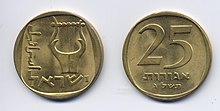
|
25 agorot | 25.5 | 6.5 | copper 92%, aluminium 6%, nickel 2% | Kinnor (lyre-like musical instrument), "Israel" in Hebrew and Arabic | |||

|
IL1⁄2 | 24.5 | 6.8 | copper 75%, nickel 25% | The state emblem, "Israel" in Hebrew, Arabic and English | 12.09.1963 | 31.03.1984 | |
Old Israeli shekel
| Image | Value | Technical parameters | Description | Date of | ||||
|---|---|---|---|---|---|---|---|---|
| Diameter (mm) | Mass (g) | Composition | Obverse | Reverse | Issue | Withdrawal | ||
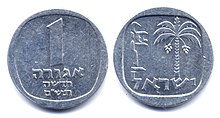
|
1 new agora | 15 | 0.6 | aluminium 97%, magnesium 3% | Palm tree, "Israel" in Hebrew and Arabic | Value, date | 24.02.1980 |
04.09.1986 |
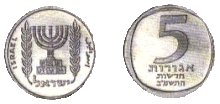
|
5 new agorot | 18.5 | 0.9 | The state emblem, "Israel" in Hebrew, Arabic and English | ||||

|
10 new agorot | 16 | 2.1 | copper 92%, nickel 8% | Three pomegranates, the state emblem, "Israel" in Hebrew, Arabic and English | |||

|
IS1⁄2 | 20 | 3 | copper 75%, nickel 25% | Lion, the state emblem, "Israel" in Hebrew, Arabic and English | Value, date, two stars | ||
- Note that all dates on Israeli coins are given in the Hebrew calendar and are written in Hebrew numerals.
Israeli new shekel
| Image | Value | Technical parameters | Description | Date of | ||||||
|---|---|---|---|---|---|---|---|---|---|---|
| Diameter | Thickness | Mass | Composition | Edge | Obverse | Reverse | Issue | Withdrawal | ||

|
1 agora | 17 mm | 1.2 mm | 2 g | Aluminium bronze 92% copper 6% aluminium 2% nickel |
Plain | Ancient galley, the state emblem, "Israel" in Hebrew, Arabic and English | Value, date | 4 September 1985 | 1 April 1991 |
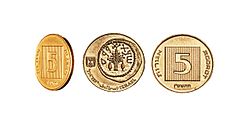
|
5 agorot | 19.5 mm | 1.3 mm | 3 g | Replica of a coin from the fourth year of the war of the Jews against Rome depicting a lulav between two etrogim, the state emblem, "Israel" in Hebrew, Arabic and English | 1 January 2008 | ||||
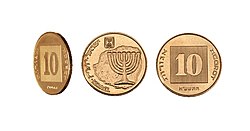
|
10 agorot/
₪1⁄10 |
22 mm | 1.5 mm | 4 g | Replica of a coin issued by Antigonus II Mattathias with the seven-branched candelabrum, the state emblem, "Israel" in Hebrew, Arabic and English | Current | ||||
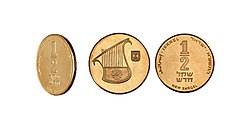
|
50 agorot/ ₪1⁄2 | 26 mm | 1.6 mm | 6.5 g | Lyre, the state emblem | Value, date, "Israel" in Hebrew, Arabic and English | ||||
- Note that all dates on Israeli coins are given in the Hebrew calendar and are written in Hebrew numerals.
See also
| Historical currencies of Israel | |||||||||||||||||||
|---|---|---|---|---|---|---|---|---|---|---|---|---|---|---|---|---|---|---|---|
| |||||||||||||||||||
References
- "agora". The Chambers Dictionary (9th ed.). Chambers. 2003. ISBN 0-550-10105-5.
- Banknotes and Coins of Israel: 1927–2006, Yigal Arkin, Bank of Israel, Currency Dept., 2006, p.91
- The Numismatist, American Numismatic Association, 1993, p.886
External links
- Bank of Israel catalogue of Israeli currency since 1948 Archived 2009-02-17 at the Wayback Machine
- Israeli Agora coins with pictures